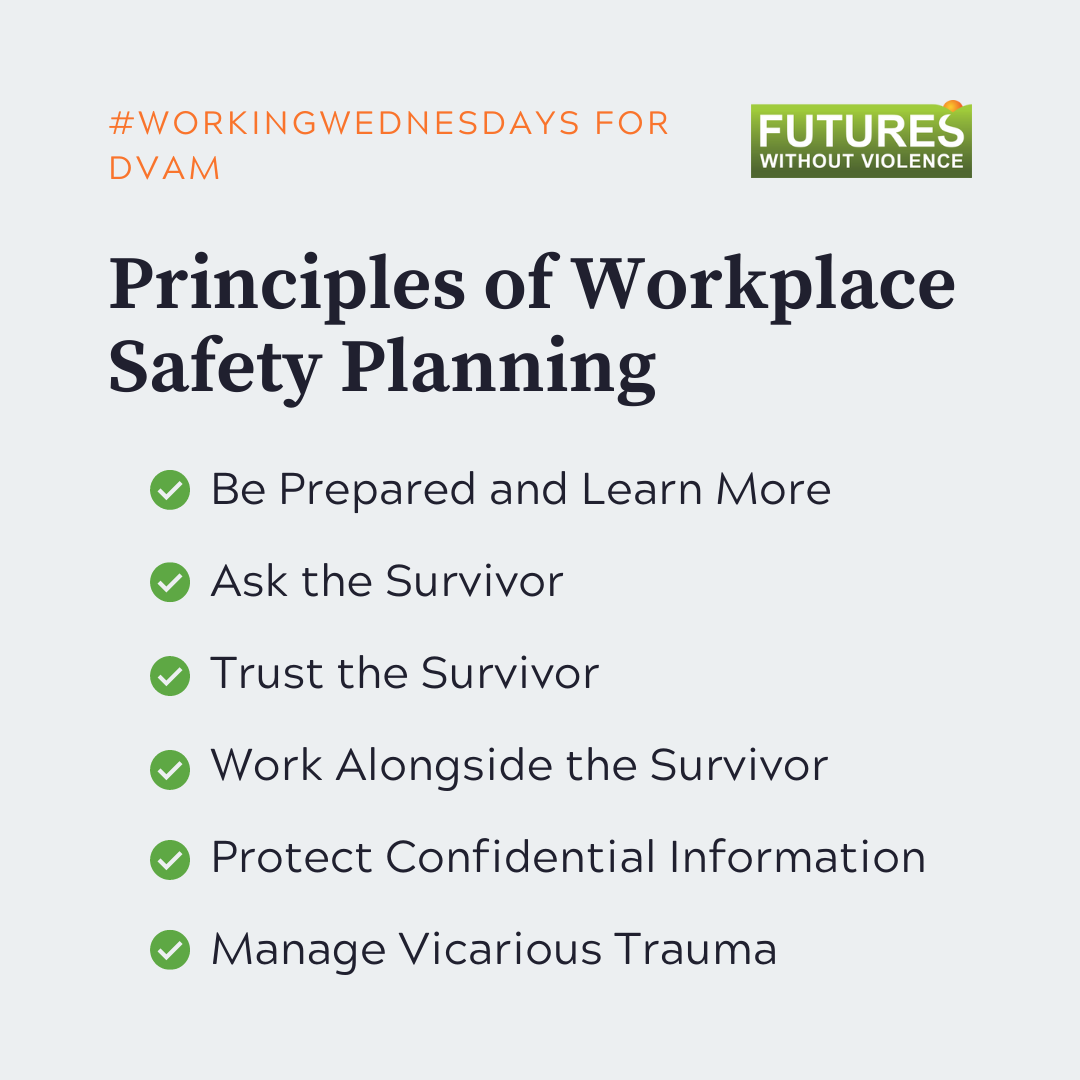DVAM: The Principles of Safety Planning for the Workplace

#WorkingWednesdays
In the United States, over the course of their lifetime, 38.9 million women and 19.1 million men will be stalked, and 43.6 million women and 37.3 million men will experience intimate partner violence. These forms of gender-based violence and harassment (GBVH) impact approximately 51% of American workers. Furthermore, rates of violence are exacerbated by intersecting forms of systemic oppression. Trans and LGBTQIA+ people experience particularly high rates of many forms of GBVH. Black women and immigrant women also experience GBVH at disproportionate rates. People with disabilities, and people living in institutions, such as prisons or congregate care settings, are at increased risk.
GBVH impacts many aspects of life including the workplace. For example, more than 18% of survivors reported experiencing IPV within the workplace, 83% reported that IPV disrupted their ability to work, and 37.7% of disabled survivor’s reported losing their job as a result of violence. From lost productivity to workplace shootings, workplaces are deeply impacted by GBVH and must respond in a variety of ways. One useful tool for protecting employees and prioritizing safety is creating a workplace safety plan.
What is a workplace safety plan?
A safety plan is a survivor-led tool that outlines a set of actions that can help lower the risk of experiencing violence. There are two types of safety plans in the context of the workplace – one specific to the employee experiencing violence (personal safety plan) and one focused on the overall workplace (workplace safety plan). For example, a personal safety plan might include all the places a survivor frequents, such as a gym, transportation hub, school, or grocery store. A workplace safety plan is localized in the workplace, involves a variety of relevant parties, nd compliments a personal safety plan. This might include changing a survivor’s work schedule, notifying a supervisor, or enhancing security on site. These complimentary plans are designed to reduce the chance that a harm-doer will be able to harass or harm the employee at work.
Responsibilities of Employers: An Example from Missouri
Employers are not expected to develop a comprehensive safety plan for those who are experiencing violence or harassment. Some states, however, do require that employers offer reasonable accommodations that could be included in a workplace safety plan.
For example, under Missouri law (Mo. Rev. Stat. 285.650), employers with at least 20 employees must make reasonable safety accommodations for their employees for circumstances related to domestic and sexual violence. This applies both to employees who have been subjected to domestic or sexual violence or an employee’s family or household member who has been subjected to domestic or sexual violence. 1 Examples of “reasonable accommodation” include an adjustment to a job structure, workplace facility, or work requirements, such as transfer, reassignment, modified schedule, leave, a changed telephone number or seating assignment, installation of a lock, and implementation of a safety procedure,
Individuals may also be eligible for reasonable accommodations under other laws or policies, including those that might afford reasonable accommodations for a disability related to domestic violence or sexual assault. Federal law, local law, and/or employers’ internal policies may provide other applicable protections.
Principles of Workplace Safety Planning
Effective safety planning focuses on building on the existing strengths of survivors of violence while placing the survivor’s needs and goals at the center. Preparation benefits both employees and employers, mitigating risk and increasing retention and productivity for survivors and their colleagues. Workplace safety plans are iterative tools and often change depending on the needs of the survivor. The principles below offer guidance for employers on how to approach this process.
- Be prepared and learn more.
- Ensure that your workplace has an explicit GBVH policy and a clear, confidential contact person for survivors.
- Research local hotlines, shelters, and prevention organizations and create a list. These advocates offer further safety planning resources. Learn more about the impacts and dynamics of GBVH and the workplace here.
- Learn more about protection orders.
- Ask the survivor if they would like to create a workplace safety plan.
- Survivors are experts in their situation. Survivors might choose to include workplaces in their safety planning but how and when to do so is their decision.
- Ask the survivor if they would like to be connected to local resources. If so, provide a list of local resources and information for the National Domestic Violence Hotline (800-799-SAFE)
- Do not involve anyone, particularly law enforcement, in the creation of the workplace safety plan without the survivor’s direction and consent.
- Trust the survivor.
- Take the lead from survivors regarding when and how to discuss a safety plan, update the plan, and manage new risks.
- Avoid directions, the words “should” “I” or “must” and limit demands. Instead, ask open-ended questions, listen carefully, and respond to concerns. Support this by establishing clear and confidential communication procedures.
- Work alongside the survivor to conduct a thoughtful risk assessment and create context-specific strategies.
- Consider the risks of the survivor’s work environment including areas open to the public, transportation and commute to/during work, and publicly available contact information.
- Following this risk assessment consider strategies to mitigate risk, often with basic security measures. For example- depending on the wishes of the survivor- provide a photo of the potential harm doer to staff, improve security in entrances or exits, improve lighting and remove or change the survivor’s work contact information.
- Protect confidential information.
- Let survivors decide what, when, and how to share information.
- Do not share the survivor’s location, schedule, emergency contact information, or contact information.
- Make sure survivors are made aware of who in the workplace must be notified as part of the safety plan and what information will be shared.
- Manage vicarious trauma
- Learning about GBVH in your community or workplace can be upsetting or triggering. Seek out support from GBV experts and mental health advocates and proactively provide support to employees.





